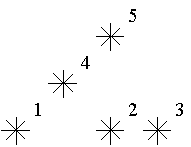Stars
| Time Limit: 1000MS | Memory Limit: 65536K | |
| Total Submissions: 48138 | Accepted: 20778 |
Description
Astronomers often examine star maps where stars are represented by points on a plane and each star has Cartesian coordinates. Let the level of a star be an amount of the stars that are not higher and not to the right of the given star. Astronomers want to know
the distribution of the levels of the stars.

For example, look at the map shown on the figure above. Level of the star number 5 is equal to 3 (it's formed by three stars with a numbers 1, 2 and 4). And the levels of the stars numbered by 2 and 4 are 1. At this map there are only one star of the level 0, two stars of the level 1, one star of the level 2, and one star of the level 3.
You are to write a program that will count the amounts of the stars of each level on a given map.

For example, look at the map shown on the figure above. Level of the star number 5 is equal to 3 (it's formed by three stars with a numbers 1, 2 and 4). And the levels of the stars numbered by 2 and 4 are 1. At this map there are only one star of the level 0, two stars of the level 1, one star of the level 2, and one star of the level 3.
You are to write a program that will count the amounts of the stars of each level on a given map.
Input
The first line of the input file contains a number of stars N (1<=N<=15000). The following N lines describe coordinates of stars (two integers X and Y per line separated by a space, 0<=X,Y<=32000). There can be only one star at one point of the plane. Stars
are listed in ascending order of Y coordinate. Stars with equal Y coordinates are listed in ascending order of X coordinate.
Output
The output should contain N lines, one number per line. The first line contains amount of stars of the level 0, the second does amount of stars of the level 1 and so on, the last line contains amount of stars of the level N-1.
Sample Input
5 1 1 5 1 7 1 3 3 5 5
Sample Output
1 2 1 10
如果不懂树状数组,可以参考博客:http://blog.youkuaiyun.com/passer__/article/details/76653144
题意:给你很多的点,这些点代表星星的位置,在一个二维坐标系上,第一个是X,第二个是Y,然后求每个星星的等级,
它的等级取决于它的左下有多少星星满足(x<=x0 && y<=y0);最后从等级1开始输出,最高是n,每个人最低是1(因为他自己本身)
树状数组,输入的时候开始建立。
#include<stdio.h> #include<string.h> int a[15100];//记录LV 为0~15000都有几个星星 (星星的个数) int c[32100];//树状数组 int lowbit(int x) { return x&(-x); } int sum(int x) { int sum=0; while(x>0) { sum=sum+c[x]; x=x-lowbit(x); } return sum; } void sum1(int x) { while(x<=32010) { c[x]++;//管理的星星+1 x=x+lowbit(x); } } int main() { int n,x,y; while(scanf("%d",&n)!=EOF) { memset(a,0,sizeof(a));//清空记录星星个数的数组 memset(c,0,sizeof(c)); int t=n; while(t--) { scanf("%d%d",&x,&y); a[sum(++x)]++; //从1开始 因为树状数组是从1开始的 输入的点可能是0 所有加1处理 sum1(x);//将此点之后所有的父亲以上的节点 +1; } for(int i=0;i<n;i++) printf("%d\n",a[i]); } return 0; }





















 400
400

 被折叠的 条评论
为什么被折叠?
被折叠的 条评论
为什么被折叠?








